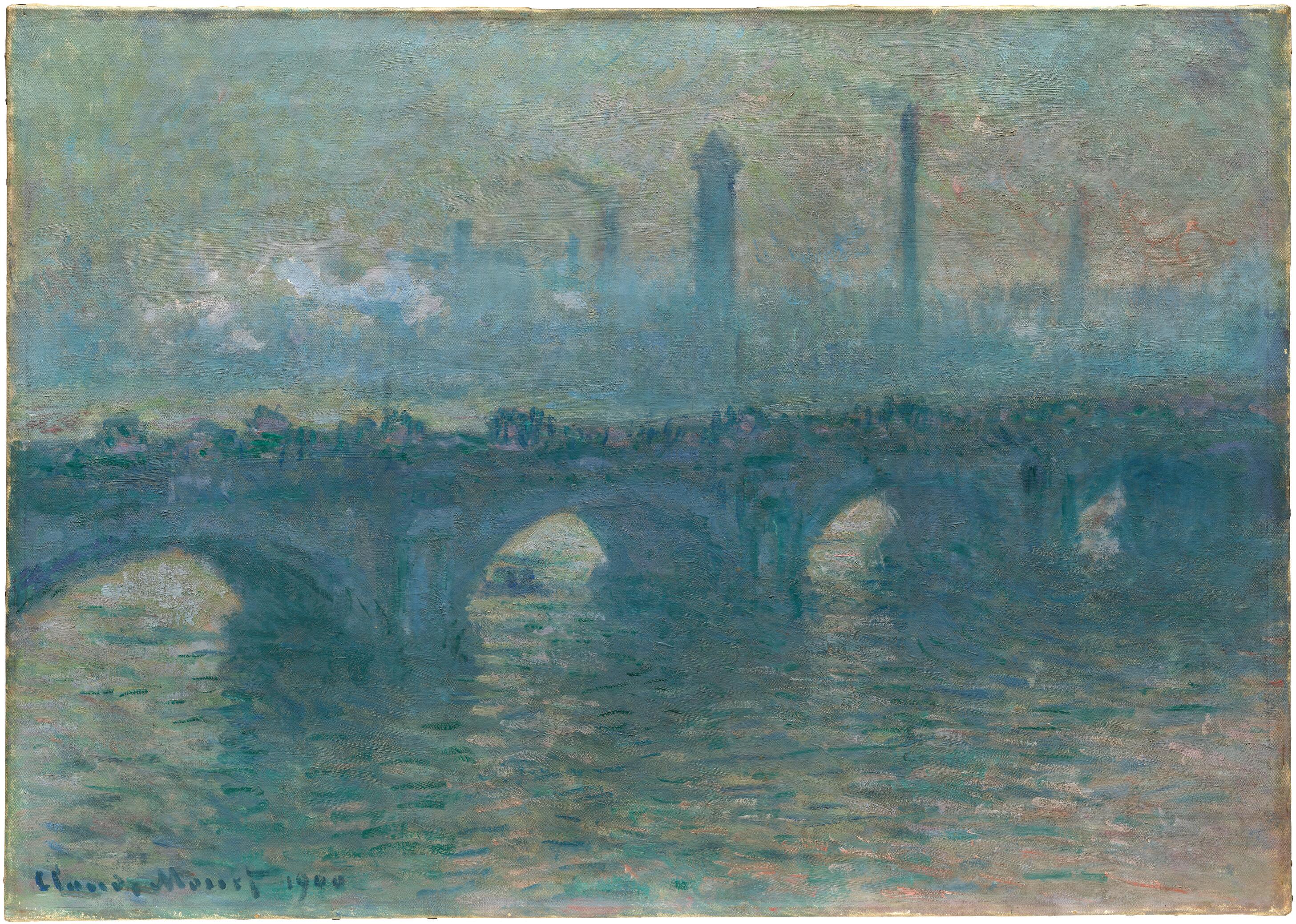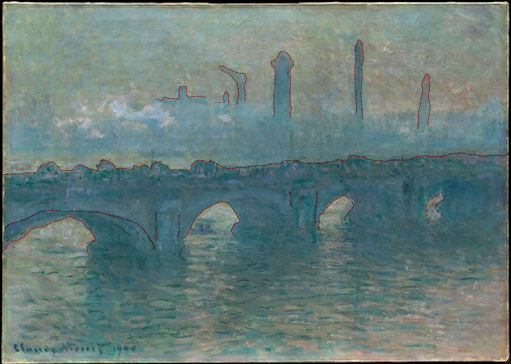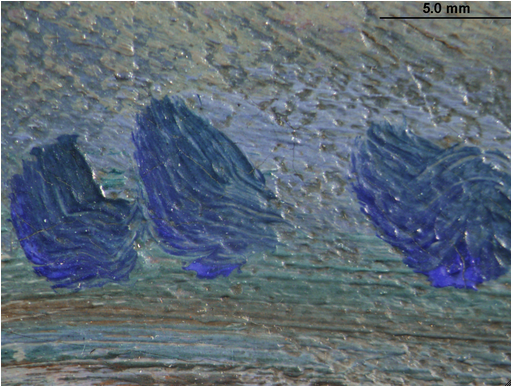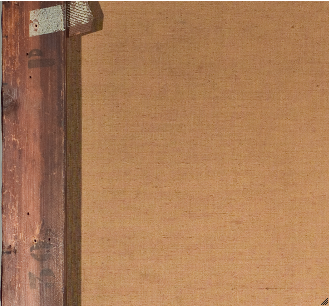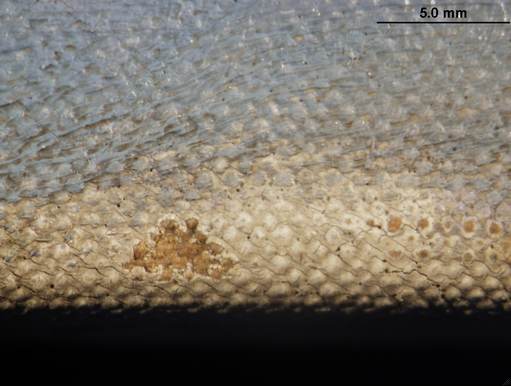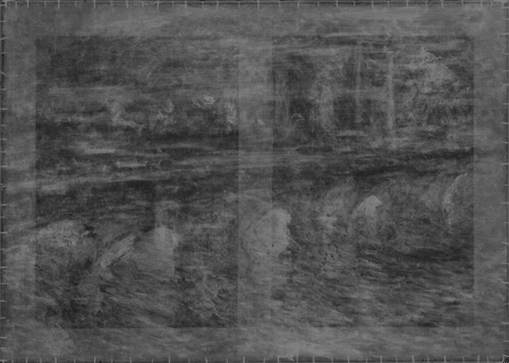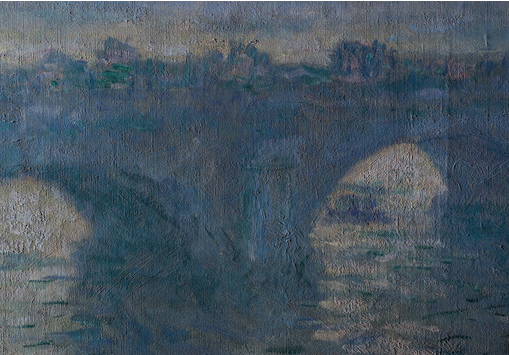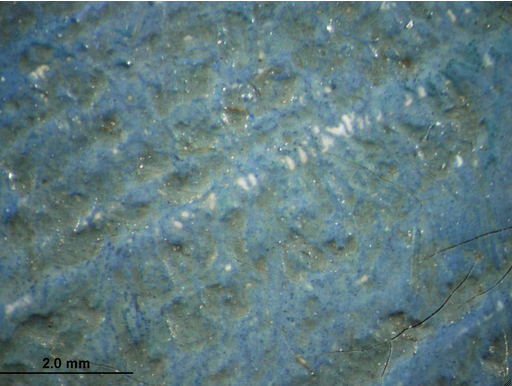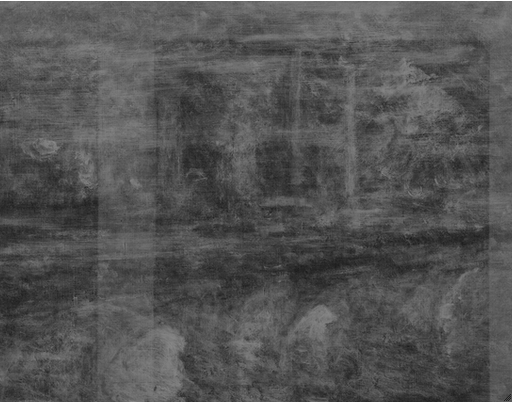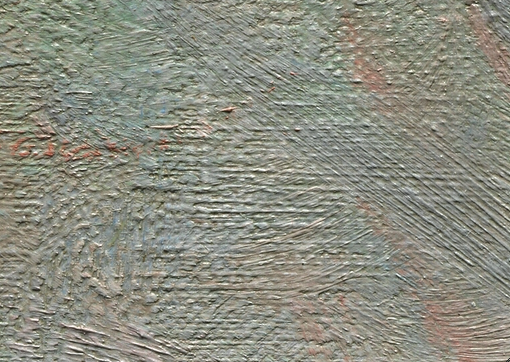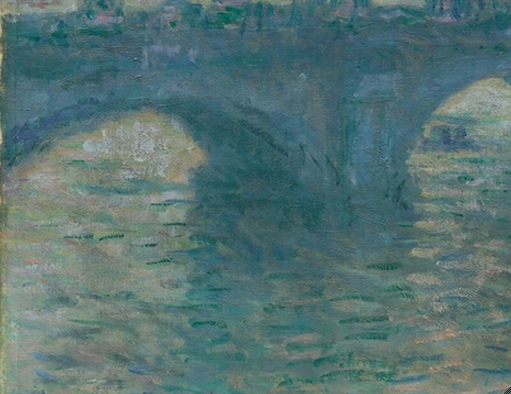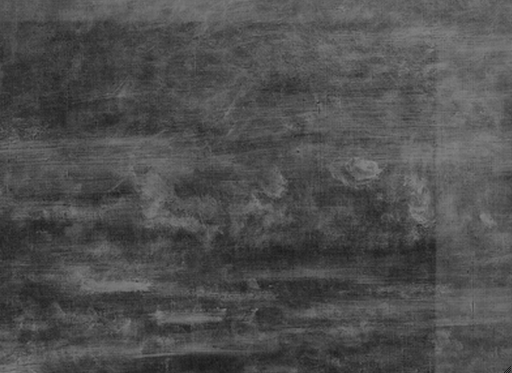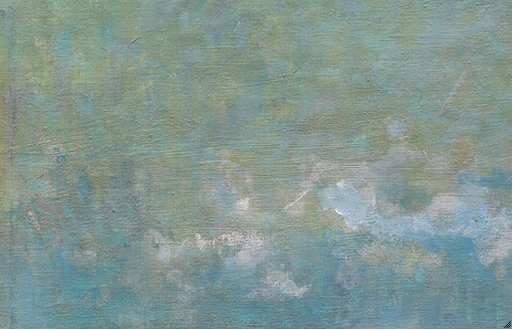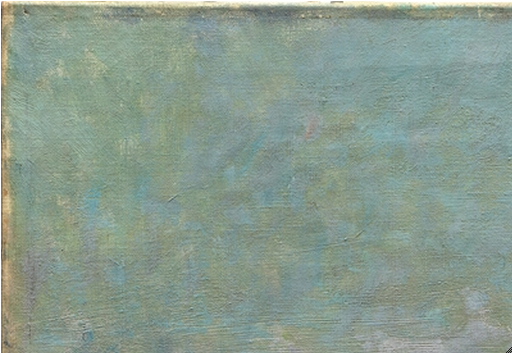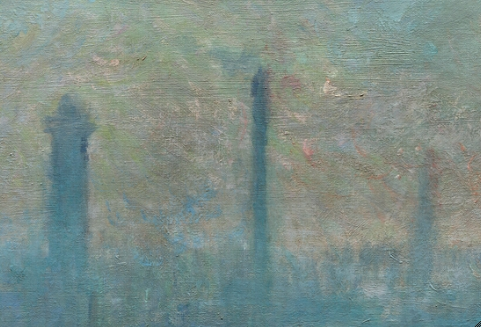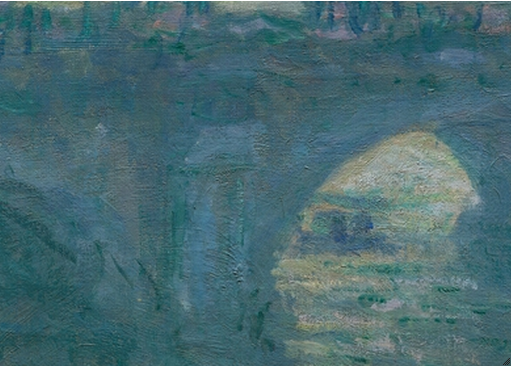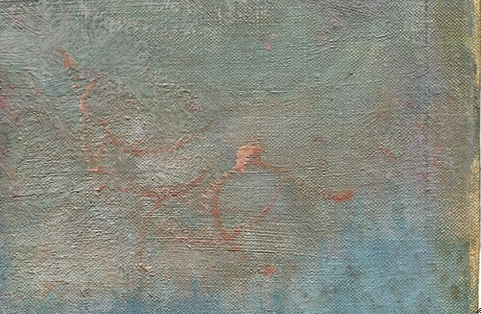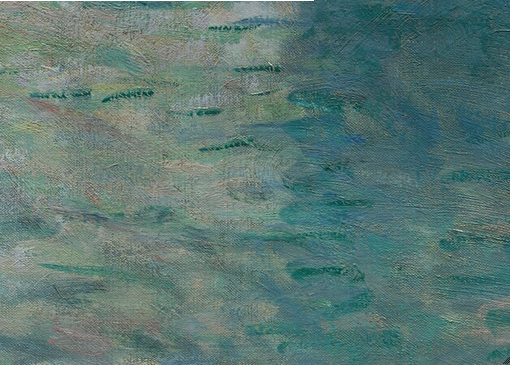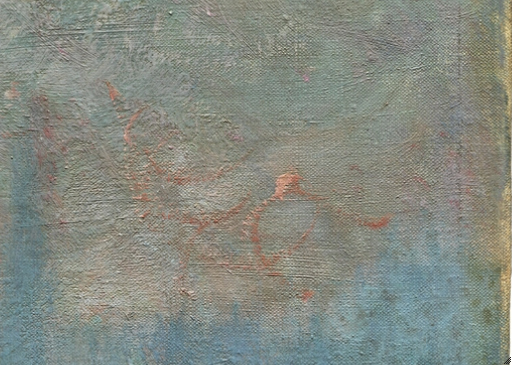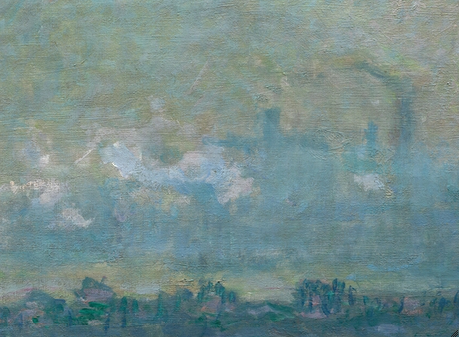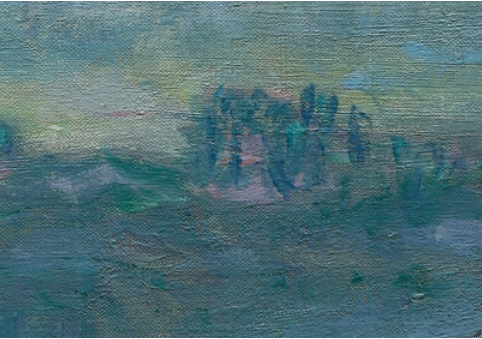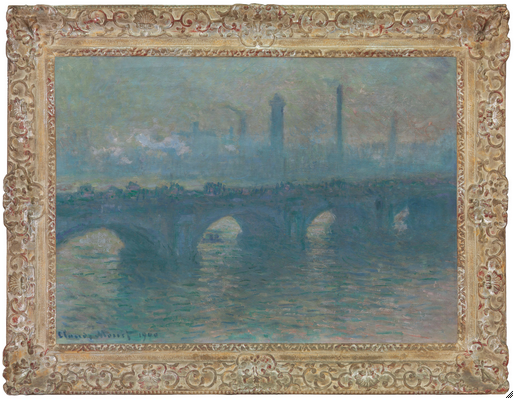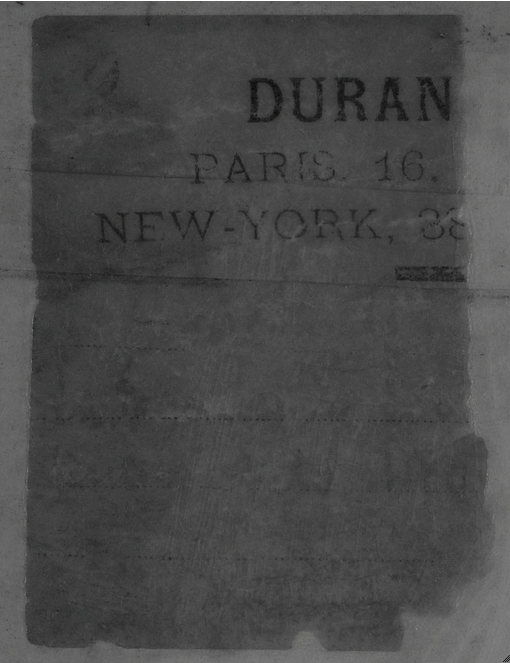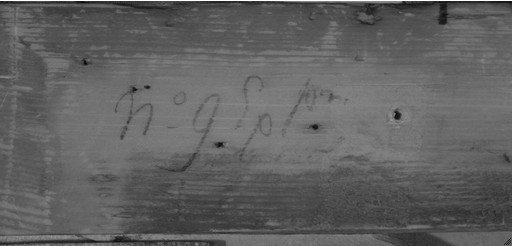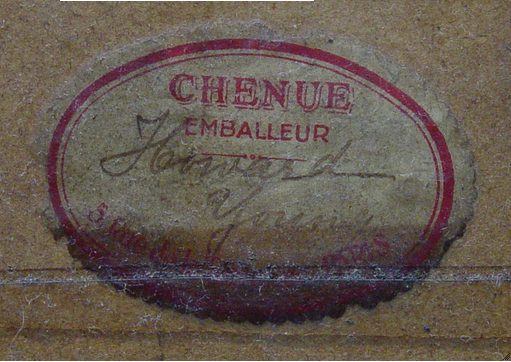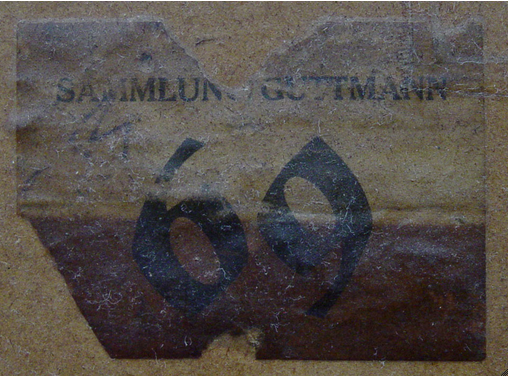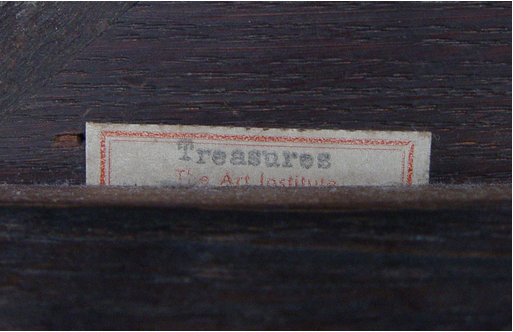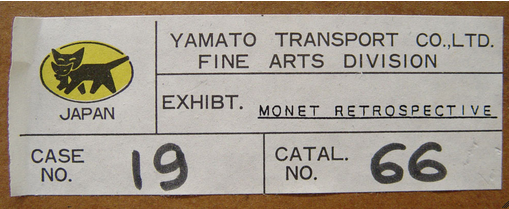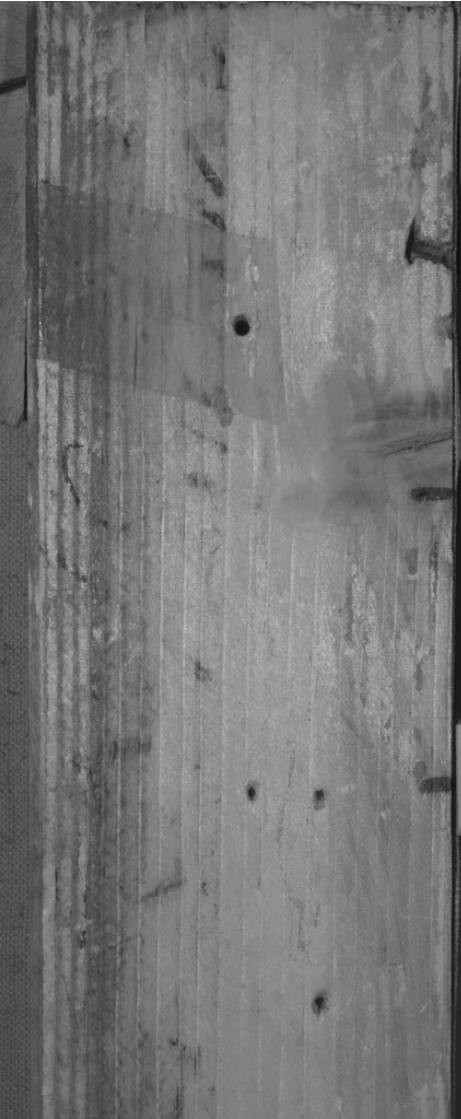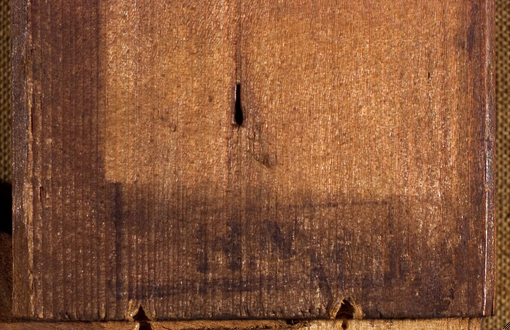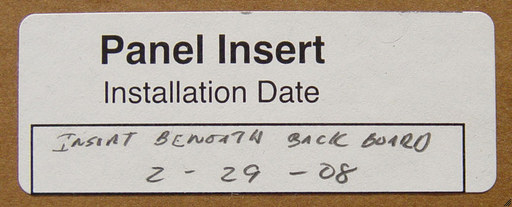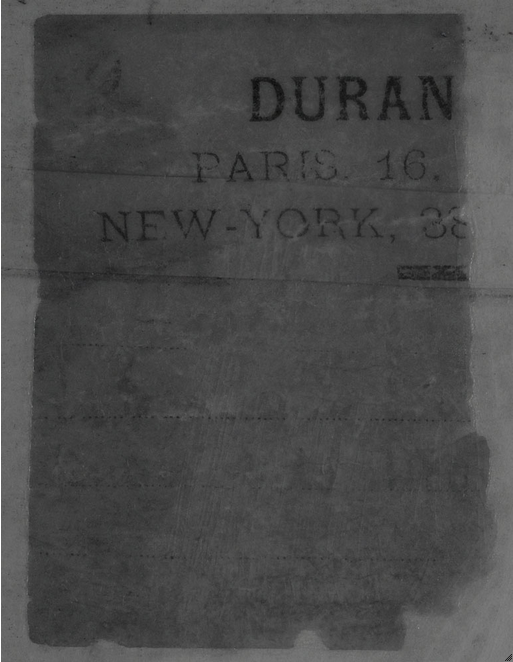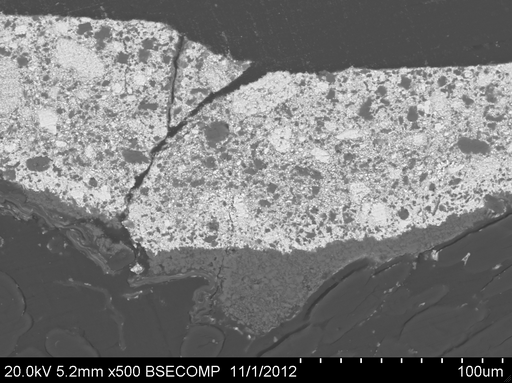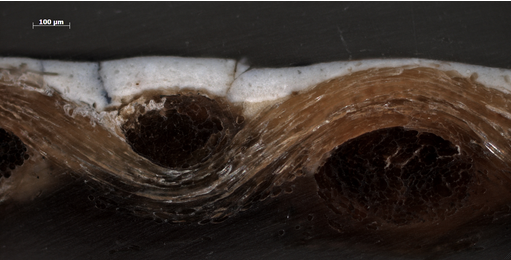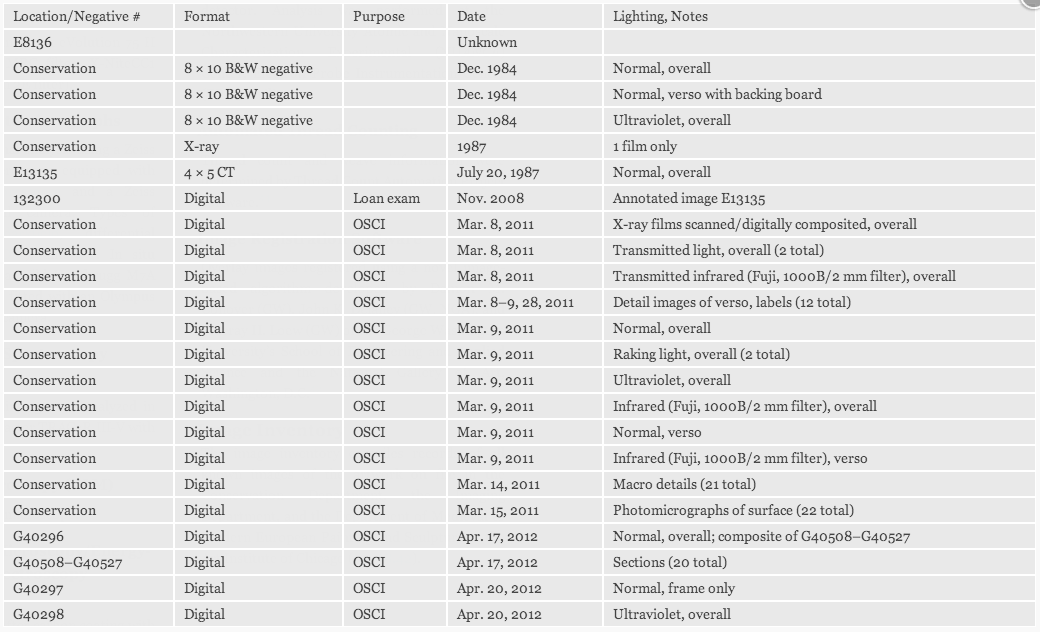Cat. 38
Waterloo Bridge, Gray Weather
1900
Oil on canvas; 65.4 × 92.6 cm (25 3/4 × 36 3/8 in.)
Signed and dated: Claude Monet 1900 (lower left, in a mixture of blue and green paints)
The Art Institute of Chicago, gift of Mrs. Mortimer B. Harris, 1984.1173
Technical Report
Technical Summary
Claude Monet’s Waterloo Bridge, Gray Weather was painted on a [glossary:pre-primed], no. 30 landscape ([glossary:paysage]) standard-size [glossary:canvas]. There is a 30 P stamp on the back of the [glossary:stretcher]. The painting is unlined and retains its original stretcher. A [glossary:warp-thread match] was detected with Monet’s Vetheuil (1901; 1933.447 [W1643]) (cat. 42), suggesting that the fabric for these paintings came from the same [glossary:bolt] of material. The off-white [glossary:ground] consists of two layers. The composition is dominated by bluish-gray tones with touches of local color applied in the foreground to define some of the forms. The brushwork is open, consisting mainly of a buildup of individual strokes. For the most part, the paint is relatively thinly applied, with the surface texture coming mainly from the canvas [glossary:weave] and a few low-relief brush marks. Changes in the spacing and angle of the arches of the bridge, as well as a change in the position of one or two of the smokestacks, indicate that the composition was initially painted from a significantly different perspective, one in which the bridge would have cut across the canvas at a sharper angle.
Multilayer Interactive Image Viewer
The multilayer interactive image viewer is designed to facilitate the viewer’s exploration and comparison of the technical images (fig. 38.1).
Signature
Signed and dated: Claude Monet 1900 (lower left, in blue paint) (fig. 38.2). Some of the underlying brushstrokes were still wet when the signature and date were applied (fig. 38.3).
Structure and Technique
Support
Canvas
Flax (commonly known as linen).
Standard format
The dimensions correspond closely to a no. 30 landscape (paysage) standard-size canvas (65 × 92 cm) (see Manufacturer’s supplier’s marks).
Weave
[glossary:Plain weave]. Average [glossary:thread count] (standard deviation): 17.0V (0.6) × 19.8H (0.5) threads/cm; the horizontal threads were determined to correspond to the [glossary:warp] and the vertical threads to the [glossary:weft]. A warp-thread match was found with Monet’s Vetheuil (1901; 1933.447 [W1643]) (cat. 42).
Canvas characteristics
There is mild, fairly regular [glossary:cusping] along all four edges of the canvas.
Stretching
Current stretching: The painting appears to retain its original stretching with iron tacks spaced approximately 5.5–7 cm apart. The cusping pattern appears to correspond to the placement of the original tacks. An additional set of copper tacks has been added more recently, in between the original tacks. On each tacking edge, there are two pairs of empty holes, each accompanied by numbers handwritten in black marker, starting from 1 on the bottom edge, running clockwise to 8 on the right edge (there is only one hole at 5 but the second hole may have been used for one of the copper tacks). The purpose of these holes is uncertain but may relate to framing.
Original stretching: See above.
Stretcher/strainer
Current stretcher: The painting appears to retain its original stretcher (fig. 38.4). It is a five-membered wooden stretcher with a vertical [glossary:crossbar], [glossary:mortise and tenon joints, and ten [glossary:keys]. Dimensions: outer depth, 2.0 cm; inner depth, approx. 1.8 cm; stretcher-bar width, 6.5 cm; crossbar width, 6.0 cm; crossbar depth, 1.2 cm.
Original stretcher: See above.
Manufacturer’s/supplier’s marks
Stamp on stretcher back: 30 P (fig. 38.5).
Preparatory Layers
Sizing
Not determined (probably glue).
Ground application/texture
The ground extends to the edges of all four [glossary:tacking margins], indicating that the canvas was cut from a larger piece of primed fabric, which was probably commercially prepared. There are many bubble holes in the ground layer (fig. 38.6). [glossary:Cross-sectional analysis] indicates that the ground consists of two layers; this is consistent in samples from both the tacking edge and the picture plane (fig. 38.7, fig. 38.8). The lower layer ranges from approximately 5 to 40 µm in thickness. The upper layer ranges from approximately 20 to 130 µm in thickness.
Color
The ground is off-white, with some dark and red or brown particles visible under magnification.
Materials/composition
Analysis indicates that the lower layer contains calcium carbonate (chalk) with traces of silicates and possible calcium sulfate. The upper layer contains lead white and calcium carbonate (chalk) with traces of alumina, silica, and silicates. Binder: [glossary:Oil] (estimated).
Compositional Planning/Underdrawing/Painted Sketch
Extent/character
No [glossary:underdrawing] was observed with [glossary:infrared reflectography] (IRR) or microscopic examination.
Paint Layer
Application/technique and artist’s revisions
Technical examination has revealed that some major alterations were made to the bridge and the two prominent smokestacks on the right side of the painting. The changes suggest that the artist initially painted the scene from a different perspective. The [glossary:X-ray] shows that the arches of the bridge were originally offset from their final placement and were also more closely spaced (fig. 38.9). The texture of the underlying strokes remains evident on the surface of the painting, especially when viewed in raking light (fig. 38.10). Where paint from the earlier composition is visible on the surface, it appears to be off-white or light in color, with the blues and greens of the final bridge and water painted directly on top (fig. 38.11). The tallest smokestack was initially painted further to the right (fig. 38.12). Under magnification, some pale-bluish-gray paint, which seems to be related to the painted-out smokestack, can be seen through breaks in the upper brushwork (fig. 38.13). A dense, [glossary:radio-opaque] area to the right of the broader, slightly shorter stack to the left may indicate that it was also initially painted further to the right. If this was the case, the two stacks would have originally been positioned closer to one another. Some dark-blue paint was observed below the surface in this area (fig. 38.14). These changes indicate that the scene was originally painted from a sharper angle, with the near side of the bridge beginning closer to the lower-left corner of the canvas and the far side ending close to or slightly above its position in the final painting. The orientation of some underlying brushstrokes at the lower-left corner, just visible at the edge of the [glossary:transmitted-infrared] image, could indicate that part of an additional arch was originally included at the left side of the bridge in the initial composition (fig. 38.15). A few areas of radio-opaque brushwork along the distant cityscape, which appear similar to the puffs of smoke visible on the surface, seem to suggest that the artist made some changes to the smoke clouds as this area was built up (fig. 38.16), but it is unclear whether the painted-out “clouds” were associated with the earlier composition or the final painting.
Microscopic examination of the painting surface indicates that a warm, off-white toning layer covers broad areas of the canvas in the area underneath the water and the bridge. The long, horizontal strokes in the underpainting of the sky seem to consist of a similar warm, off-white layer (fig. 38.17). The brushstrokes of this underlayer continue underneath the two most prominent smokestacks.
In the final composition, the work was painted using relatively loose, open brushwork and mostly thin applications of paint. Overall, the surface of the painting is quite flat, and includes little impasto or thickly textured brushwork; however, variations in surface are created through a combination of thin strokes that leave the texture of the canvas weave prominent (fig. 38.18); low-relief brush marks (fig. 38.19) (including those related to the earlier composition); areas of smooth, more fluid paint application (fig. 38.20); and light strokes that catch the high points of the dry brushstrokes underneath (fig. 38.21).
The palette consists predominantly of various gray hues, with only individual touches of more intense color—mainly blues and greens—used in the foreground to help delineate details like the traffic on the bridge and the ripples in the water. Often, these more intensely colored strokes were final additions to the painting; for example, the deep-green horizontal dashes in the water (fig. 38.22). At the upper-right and lower-right corners, a few strokes of warm pink and orange suggest light from the sun just outside of the frame (fig. 38.23). There is little actual blending of brushwork on the canvas. Even the structures in the distance, which visually blur into one another, consist of individual strokes and touches, although using a more monochromatic range of colors (fig. 38.24). Only a few areas, such as the vehicles on the bridge, involve some localized [glossary:wet-in-wet paint] application (fig. 38.25). Some areas of flattened paint around the edges suggest that the work may have been framed when the paint was still soft.
Painting tools
Brushes, including 1.0 cm width, flat ferrule (based on width and shape of brushstrokes). A few brush hairs are embedded in the paint layers.
Palette
[glossary:XRF] analysis indicates the presence of the following [glossary:pigments]: lead white, vermilion, viridian, cobalt blue, and cobalt violet.
Binding Media
Oil (estimated).
Surface Finish
Varnish layer/media
The painting was cleaned in 1987 and left unvarnished; however, there appears to be a fair amount of discolored [glossary:varnish] residue and dirt embedded in the recesses of the paint texture throughout the surface. This is especially evident in the fine “line” that runs around the edges, just inside the frame [glossary:rebate] area. Microscopically, these residues are very dark and they affect the overall tonality of the work. It also seems that the varnish was only thinned in some areas, or selectively removed, resulting in an uneven surface of variable gloss (see Conservation History).
Conservation History
A note in the conservation file indicates that the painting may have been cleaned in 1968/69.
In 1987, surface grime and yellowed varnish were removed.
Condition Summary
The painting is in excellent condition. It is unlined and appears to retain its original stretcher and tacking. The canvas is stable and remains relatively flexible. The stretcher is keyed out slightly. The tension is good and there are no planar deformations. The paint layer is secure with only a couple of small losses near the edges and minor abrasion in the frame rebate area. There is a general network of very fine cracks that are visible microscopically. Slightly more pronounced cracks are visible in areas where the paint is thicker or more built up in layers. There are also [glossary:stretcher-bar cracks], which are most pronounced along the vertical members. There is an area of scattered brown accretions at lower center, which appear to be old, as well as a few localized, resinous accretions on the left side. Traces of gold from the frame are visible near the edges. There are four marks, possibly executed in pencil, which extend from the [glossary:foldover] onto the picture plane, on the right and bottom sides. Their origin and purpose are unknown. A heavily discolored, natural-resin varnish and thick surface grime and nicotine were removed in 1987, and the painting was left unvarnished. The surface is currently rather uneven, with residual varnish remaining in some areas and older, dark varnish residues and dirt embedded in the recesses of the paint texture throughout the work. This seems to make the painting darker and patchier than it should appear. Cotton fibers are embedded in the residual varnish in places.
Kimberley Muir
Frame
Current frame: The frame is not original to the picture. It is a French, late-seventeenth–early-eighteenth-century, Louis IV, ogee frame with carved anthemion corner cartouches and fleur-de-lis center cartouches linked by foliate scrollwork and centered shells on a quadrillage bed, sanded frieze, and ogee leaf-tip-and-tongue sight molding. The original gilded surface has been entirely compromised by an overpainted décapé-like finish. It is painted overall with a whitened, raw umber base with highlights in red and scattered passages of silver leaf. The carved oak molding is mitered and joined with angled dovetails. The impression of hardware marks from the original forged hanging plate remain on the back of the top frame molding. The molding, from perimeter to interior, is ovolo with carved dentil; scotia side; ogee face with carved anthemion corner cartouches and fleur-de-lis center cartouches, linked by foliate scrollwork and centered shells on a quadrillage bed; sanded frieze; and ogee carved with leaf-tip-and-tongue on the sight molding (fig. 38.26).
Kirk Vuillemot
Provenance
Sold by the artist to Durand-Ruel, Paris, May 11, 1904, for 9,000 francs.
Sold by Durand-Ruel, Paris, to Paul Cassirer, Berlin, Nov. 28, 1904, for 11,500 francs.
Acquired by Albrecht Guttmann, Berlin, by May 18, 1917.
Sold at the Albrecht Guttmann, Berlin, sale, Paul Cassirer (Berlin) and Hugo Helbing (Munich), Berlin, May 18, 1917, lot 69.
Acquired by Howard Young, New York.
Acquired by Mrs. Potter Palmer, Chicago.
Acquired by Anderson Gallery, Chicago, c. 1927.
Sold by Anderson Gallery, Chicago, to William Redfield, Chicago, c. 1927.
Given by William Redfield, Chicago, to his sister, Mrs. Mortimer B. (Ethel R.) Harris, Chicago, c. 1930.
Given by Mrs. Mortimer B. (Ethel R.) Harris, Chicago, to the Art Institute of Chicago, beginning in 1984.
Exhibition History
Probably Paris, Galeries Durand-Ruel, Claude Monet: Vues de la Tamise à Londres, May 9–June 4, 1904, cat. 9, as Temps gris. 1900, under the heading Waterloo Bridge.
Berlin, Paul Cassirer, Neue Ausstellung, Werke von: Claude Monet, Louis Corinth, Hans Thoma, Manet, Degas. Skulpturen von Rodin u.A., Oct. 9–Nov. 20, 1904, cat. 5, as Waterloo Bridge, temps gris.
Art Institute of Chicago, Treasures of Chicago Collectors, Apr. 15–May 7, 1961, no cat. no.
Art Institute of Chicago, Masterpieces from Private Collections in Chicago, July 12–Aug. 31, 1969, no cat. no.
Tokyo, Bridgestone Museum of Art, Mone ten [Monet, a retrospective], Feb. 11–Apr. 7, 1994, cat. 66 (ill.); Nagoya City Art Museum, Apr. 16–June 12, 1994; Hiroshima Museum of Art, June 18–July 31, 1994.
Shelburne (Vt.) Museum, Apr. 19–Nov. 3, 1995, no cat.
Fort Worth, Tex., Kimbell Art Museum, The Impressionists: Master Paintings from the Art Institute of Chicago, June 29–Nov. 2, 2008, cat. 86 (ill.).
Selected References
Probably Galeries Durand-Ruel, Claude Monet: Vues de la Tamise à Londres, exh. cat. (Galeries Durand-Ruel, 1904), p. 10, cat. 9.
R. de Bettex, “Échos de partout. Claude Monet,” La république française, May 10, 1904, p. 1.
Daniel Catton Rich, “Französische Impressionisten im Art Institute zu Chicago,” Pantheon: Monatsschrift für freunde und sammler der kunst 11, 3 (Mar. 1933), p. 77. Translated by C. C. H. Drechsel as “French Impressionists in the Art Institute of Chicago,” Pantheon/Cicerone (Mar. 1933), p. 18.
Art Institute of Chicago, Treasures of Chicago Collectors, exh. cat. (Art Institute of Chicago, 1961), n. pag.
Art Institute of Chicago, Masterpieces from Private Collections in Chicago, exh. cat. (Art Institute of Chicago, [1969]), n. pag.
Art Institute of Chicago, Art Institute of Chicago Annual Report, 1984-85 (Art Institute of Chicago, 1985), pl. 12.
Daniel Wildenstein, Claude Monet: Biographie et catalogue raisonné, vol. 4, Peintures, 1899–1926 (Bibliothèque des Arts, 1985), pp. 170; 171, cat. 1557 (ill.); 365, letters 1723, 1724; 427, pièces justificatives 169, 170.
Richard R. Brettell, Post-Impressionists (Art Institute of Chicago/Abrams, 1987), pp. 91; 94 (ill.); 118.
Daniel Wildenstein, Claude Monet: Catalogue raisonné, vol. 5, Supplément aux peintures: Dessins; Pastels; Index (Wildenstein Institute, 1991), p. 52, cat. 1557.
Bridgestone Museum of Art, Ishibashi Foundation; and Nagoya City Art Museum, eds., Mone ten [Monet, a retrospective], exh. cat. (Chunichi Shimbun, 1994), p. 188, cat. 66 (ill.).
Paul Hayes Tucker, “Of Sites and Subjects and Meaning in Monet’s Art,” in Bridgestone Museum of Art, Ishibashi Foundation; and Nagoya City Art Museum, eds., Mone ten [Monet, a retrospective], exh. cat. (Chunichi Shimbun, 1994), pp. 37, 72.
Andrew Forge, Monet, Artists in Focus (Art Institute of Chicago, 1995), pp. 56; 57; 59 (detail); 98, pl. 27; 109.
Daniel Wildenstein, Monet: Catalogue raisonné/Werkverzeichnis, vol. 3, Nos. 969–1595 (Taschen/Wildenstein Institute, 1996), pp. 676–77, cat. 1557 (ill.).
Simonella Condemi and Andrew Forge, Claude Monet: La poesia della luce; Sette capolavori dell’ Art Institute di Chicago a Palazzo Pitti, exh. cat. (Giunti Gruppo, 1999), pp. 44 (ill.), 46.
Art Institute of Chicago, Impressionism and Post-Impressionism in the Art Institute of Chicago, selected by James N. Wood (Art Institute of Chicago/Hudson Hills, 2000), p. 156 (ill.).
Norio Shimada and Keiko Sakagami, Kurōdo Mone meigashū: Hikari to kaze no kiseki [Claude Monet, 1881–1926], vol. 2 (Nihon Bijutsu Kyōiku Sentā, 2001), pp. 112, no. 239 (ill.); 113 (detail); 190.
John E. Thornes and Gemma Metherell, “The Art and Science of London’s Atmosphere around 1900,” in London’s Enviornment: Prospects for a Sustainable City, ed. Julian Hunt (Imperial College Press, 2005), p. 119.
Jay A. Clarke, “Adrienne Farb and the Anti-Hip of Abstraction,” in The Spiritual Landscapes of Adrienne Farb, 1980–2006, ed. Jay A. Clarke and Joanna E. Ziegler, exh. cat. (Iris and B. Gerald Cantor Art Gallery, College of the Holy Cross, 2006), pp. 48–49, fig. 4.
Gloria Groom and Douglas Druick, with the assistance of Dorota Chudzicka and Jill Shaw, The Impressionists: Master Paintings from the Art Institute of Chicago, exh. cat. (Art Institute of Chicago/Kimbell Art Museum, 2008), pp. 168, cat. 86 (ill.); 169. Simultaneously published as Gloria Groom and Douglas Druick, with the assistance of Dorota Chudzicka and Jill Shaw, The Age of Impressionism at the Art Institute of Chicago (Art Institute of Chicago/Yale University Press, 2008), pp. 168, cat. 86 (ill.); 169.
Cheryl Hill, “Useful Publications: Catalogues Raisonnés,” in “Art through the Pages: Library Collections at the Art institute of Chicago,” special issue, Art Institute of Chicago Museum Studies 34, 2 (2008), pp. 63, figs. 1–2; 64.
Other Documentation
Documentation from the Durand-Ruel Archives
Inventory Number
Stock Durand-Ruel Paris 7643, Durand-Ruel, Paris, stock book for 1901–13
Photograph
Photo Druet [sic] no. 22
Label
Label (fig. 38.27)
Labels and Inscriptions
Undated
Label
Location: stretcher
Method: printed label [partial; probably also handwritten script but illegible]
Content: DURAN [. . .] / PARIS, 16 [. . .] / NEW-YORK, 38 [. . .] (fig. 38.28)
Number
Location: stretcher
Method: handwritten script
Content: no 9 [. . .] (fig. 38.29)
Label
Location: [glossary:backing board]
Method: printed label with handwritten script
Content: CHENUE / EMBALLEUR / Howard / Young / 5 Rue de la T[errasse?] PARIS (fig. 38.30)
Label
Location: backing board
Method: printed label
Content: SAMMLUNG GUTTMANN / 69 (fig. 38.31)
Label
Location: frame
Method: printed label with typewritten script
Content: Treasures / The Art Institute (fig. 38.32)
Number
Location: backing board
Method: handwritten script
Content: R of O 22672 (fig. 38.33)
Inscription
Location: backing board
Method: handwritten script
Content: COLLECTION OF: MRS. M. B. HARRIS, CHICAGO, ILLINOIS / ARTIST: CLAUDE MONET / TITLE: “THE THAMES AT LONDON-WATERLOO BRIDGE, GREY WEATHER-1900” (fig. 38.34)
Inscription
Location: frame
Method: handwritten script
Content: MRS. M. B. HARRIS MONET WATERLOO BRIDGE (fig. 38.35, fig. 38.36)
Label
Location: backing board
Method: printed label with typewritten and handwritten script
Content: [Logo] JAPAN / YAMATO TRANSPORT CO.,LTD. / FINE ARTS DIVISION / EXHIBT. MONET RETROSPECTIVE / CASE NO. / 19 / CATAL. NO. / [66] (fig. 38.37)
Inscription
Location: stretcher
Method: handwritten script
Content: illegible marks (fig. 38.38)
Stamp
Location: stretcher
Method: ink stamp?
Content: [HY?] (fig. 38.39)
Post-1980
Label
Location: backing board
Method: typewritten script on printed label
Content: The Art Institute of Chicago / Claude Monet / French, 1840–1926 / Waterloo Bridge, grey weather. / 1900 / Mrs. Mortimer B. Harris gift / 1984.1173 (fig. 38.40)
Label
Location: backing board
Method: printed label with handwritten script
Content: Panel Insert / Installation Date / INSERT BENEATH BACK BOARD / 2-29-08 (fig. 38.41)
Examination and Analysis Techniques
X-radiography
Westinghouse X-ray unit, scanned on Epson Expressions 10000XL flatbed scanner. Scans digitally composited by Robert G. Erdmann, University of Arizona.
Infrared Reflectography
Fujifilm S5 Pro with X-Nite 1000B/2 mm filter (1.0–1.1 µm); Inframetrics Infracam with 1.5–1.73 µm filter; and Goodrich/Sensors Unlimited SU640SDV-1.7RT with H filter (1.1–1.4 µm), J filter (1.5–1.7 µm).
Transmitted Infrared
Fujifilm S5 Pro with X-Nite 1000B/2 mm filter (1.0–1.1 µm); Inframetrics Infracam (1.5–1.73 µm filter).
Visible Light
Natural-light, raking-light, and transmitted-light overalls and macrophotography: Fujifilm S5 Pro with X-NiteCC1 filter.
Ultraviolet
Fujifilm S5 Pro with X-NiteCC1 filter and Kodak Wratten 2E filter.
High-Resolution Visible Light (and Ultraviolet)
Sinar P3 camera with Sinarback eVolution 75 H (B+W 486 UV/IR cut MRC filter, X-NiteCC1 filter, and Kodak Wratten 2E filter).
Microscopy and Photomicrographs
Sample and cross-sectional analysis using a Zeiss Axioplan2 research microscope equipped with reflected light/[glossary:UV fluorescence] and a Zeiss AxioCam MRc5 digital camera. Types of illumination used: [glossary:darkfield], differential interference contrast ([glossary:DIC]), and [glossary:UV]. In situ photomicrographs with a Wild Heerbrugg M7A StereoZoom microscope fitted with an Olympus DP71 microscope digital camera.
X-ray Fluorescence Spectroscopy (XRF)
Several spots on the painting were analyzed in situ with a Bruker/Keymaster TRACeR III-V with rhodium tube.
Polarized Light Microscopy (PLM)
Zeiss Universal research microscope.
Scanning Electron Microscopy/Energy-Dispersive X-ray Spectroscopy (SEM/EDX)
[glossary:Cross sections] analyzed after carbon coating with a Hitachi S-3400N-II VP-SEM with an Oxford EDS and a Hitachi solid-state [glossary:BSE] detector. Analysis was performed at the Northwestern University Atomic and Nanoscale Characterization Experimental (NUANCE) Center, Electron Probe Instrumentation Center (EPIC) facility.
Automated Thread Counting
Thread count and weave information were determined by Thread Count Automation Project software.
Image Registration Software
Overlay images registered using a novel image-based algorithm developed by Damon M. Conover (GW), John K. Delaney (GW, NGA), and Murray H. Loew (GW) of the George Washington University’s School of Engineering and Applied Science and the National Gallery of Art, Washington, D.C.
Image Inventory
The image inventory compiles records of all known images of the artwork on file in the Conservation Department, the Imaging Department, and the Department of Medieval to Modern European Painting and Sculpture at the Art Institute of Chicago (fig. 38.42).
